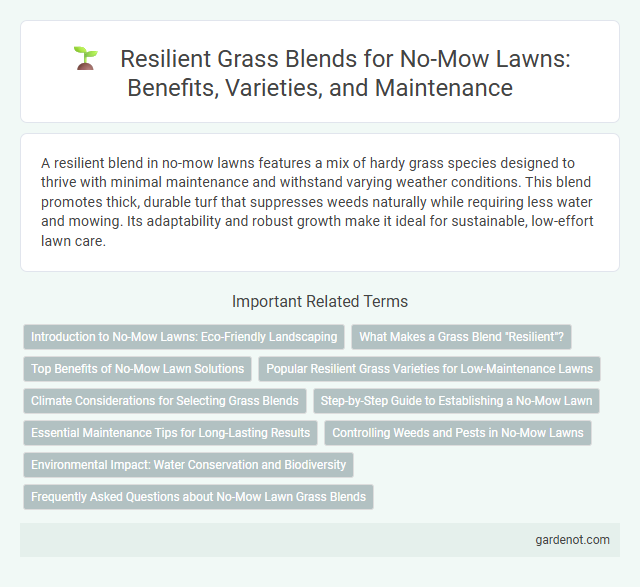A resilient blend in no-mow lawns features a mix of hardy grass species designed to thrive with minimal maintenance and withstand varying weather conditions. This blend promotes thick, durable turf that suppresses weeds naturally while requiring less water and mowing. Its adaptability and robust growth make it ideal for sustainable, low-effort lawn care.
Introduction to No-Mow Lawns: Eco-Friendly Landscaping
Resilient blends in no-mow lawns combine drought-tolerant grasses and low-maintenance ground covers to create sustainable, eco-friendly landscapes that reduce water consumption and minimize lawn care efforts. These blends prioritize native species such as fine fescue and clover, which support biodiversity and improve soil health while maintaining year-round aesthetic appeal with minimal mowing requirements. Installing a resilient blend enhances carbon sequestration and reduces chemical runoff, making it an ideal solution for environmentally conscious homeowners.
What Makes a Grass Blend "Resilient"?
A resilient grass blend for no-mow lawns typically combines drought-tolerant varieties like fine fescue, Kentucky bluegrass, and perennial ryegrass, which are known for their deep root systems and stress resistance. These grasses are selected for their ability to withstand foot traffic, resist pests and diseases, and recover quickly from environmental stresses. The blend's resilience is further enhanced by its capacity to maintain green color and density with minimal watering and mowing, promoting a sustainable and low-maintenance lawn.
Top Benefits of No-Mow Lawn Solutions
Resilient blends for no-mow lawns combine drought-tolerant grasses and low-maintenance ground covers that reduce water usage by up to 50%, promoting sustainability and cost savings. These blends enhance soil health and prevent erosion, supporting local biodiversity by providing habitats for pollinators and beneficial insects. The minimal mowing requirement significantly cuts down on noise pollution and carbon emissions from lawn equipment, contributing to a healthier environment.
Popular Resilient Grass Varieties for Low-Maintenance Lawns
Popular resilient grass varieties for no-mow lawns include fine fescues such as chewings fescue, creeping red fescue, and hard fescue, known for their drought tolerance and shade resistance. These grasses thrive with minimal watering and mowing while maintaining dense, lush turf that naturally suppresses weeds. Their deep root systems improve soil health and enhance lawn durability under low-maintenance conditions.
Climate Considerations for Selecting Grass Blends
Resilient grass blends for no-mow lawns are engineered to thrive in diverse climate conditions by combining drought-tolerant, heat-resistant, and shade-adaptive species such as fine fescues, buffalo grass, and Bermuda grass. Selecting a climate-appropriate resilient blend improves turf durability, minimizes irrigation needs, and maintains green coverage throughout seasonal changes. These climate-tailored grass blends support eco-friendly landscaping with reduced mowing frequency and enhanced natural stress resistance.
Step-by-Step Guide to Establishing a No-Mow Lawn
Resilient blend grass seed combines drought-tolerant fescues and fine-leaved ryegrass, ensuring durability and low maintenance for no-mow lawns. Begin by preparing the soil through aeration and removing debris to promote optimal seed-to-soil contact. Evenly spread the resilient blend, water consistently until germination, and gradually reduce watering to establish a robust, self-sustaining no-mow lawn.
Essential Maintenance Tips for Long-Lasting Results
Resilient blend no-mow lawns thrive with minimal care, requiring only seasonal fertilization and occasional overseeding to maintain density and color. Proper watering practices involve deep, infrequent irrigation to encourage strong root systems that enhance drought tolerance. Regularly monitoring for weeds and promptly addressing them ensures long-lasting, resilient turf without the need for frequent mowing.
Controlling Weeds and Pests in No-Mow Lawns
Resilient blend grasses in no-mow lawns enhance natural weed and pest control by promoting dense turf growth that crowds out invasive species and disrupts pest habitats. These specialized blends include drought-tolerant and disease-resistant grass varieties that reduce the need for chemical interventions. Maintaining a resilient no-mow lawn supports ecological balance, minimizing weed proliferation and pest infestations while ensuring a healthy, low-maintenance landscape.
Environmental Impact: Water Conservation and Biodiversity
The Resilient Blend no-mow lawn significantly reduces water usage by requiring minimal irrigation compared to traditional grass species, promoting efficient water conservation. Its diverse mix of drought-tolerant grasses and native plants supports local biodiversity, providing habitats for pollinators and beneficial insects. This environmentally sustainable approach minimizes lawn maintenance while enhancing ecosystem health and resilience.
Frequently Asked Questions about No-Mow Lawn Grass Blends
Resilient blend no-mow lawn grass blends consist of drought-tolerant species like fine fescues and bluegrasses, ensuring durability and minimal maintenance. These blends are designed to stay green year-round without regular mowing, making them ideal for busy homeowners seeking eco-friendly alternatives. Common questions often address optimal sunlight, watering needs, and longevity of the blend, with experts recommending partial shade and infrequent watering for best results.
Resilient blend Infographic

 gardenot.com
gardenot.com